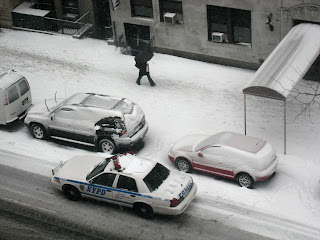 I didn't originally plan to write about Amy Bishop, the Alabama professor who (allegedly) shot six people, but the unfolding story has been too good to ignore. Since Amy spent quite a few years living and attending college in Massachusetts (where I live), the papers and the local news stations have been filled with background details, photographs, and anything else they could dig up–a few years too late.
I didn't originally plan to write about Amy Bishop, the Alabama professor who (allegedly) shot six people, but the unfolding story has been too good to ignore. Since Amy spent quite a few years living and attending college in Massachusetts (where I live), the papers and the local news stations have been filled with background details, photographs, and anything else they could dig up–a few years too late. For those of you who have remained happily oblivious of all this, here's a quick review of the facts. Amy Bishop was a high school student who looked like someone we all knew back then. She went to college and graduated cum laude. A year later she married. She obtained a Ph.D. from Harvard and held several post-doctoral research fellowship, a fairly normal career path. Finally in 2003 she obtained a faculty position as an assistant professor of biology in Alabama. Along the way she and her husband had four children. A normal life, and one that would be called successful by most popular standards.
This month that nice, normal woman shot six people; three of them died. And if you turn over that shiny resume and look at the dark side of Amy Bishop's history, the warning signs were always there.
1986: the peculiar death of Amy's younger brother, from a shotgun blast–a shotgun she admitted to holding when it went off. After the shooting she fled the scene and tried to take a car from a nearby auto dealership–still carrying the same gun.
Amy's mother said the shooting was an accident. That was the end of the investigation. The procedural issues are at best troubling:
–Amy and her mother, the only witnesses, were not questioned until 11 days after the event–Amy's story and that of her mother differed in significant details. –The attempted car theft was never investigated by police, nor the fact that Amy was wandering around threatening people with a loaded gun.
Now, of course, everybody who was involved–local police, state police, and the county district attorney–are pointing fingers at each other and whining, "but you never told us!" It was a paperwork problem?
1993: Amy and her husband were considered suspects in the mailing of two pipe bombs to one of Amy's then-supervisors, with whom she had argued. It was investigated, but no charges were filed. But why was she a person of interest?
1999-2003: Amy and her husband made frequent complaints about noisy neighbors and children playing, and were well known to the local police.
2002: Amy burst into a shrieking and profane rage and hit a woman at an IHOP because the woman would not give up the last infant seat. Amy was given probation and told to seek anger management counseling. There's no record that she did.
2010: Professor Amy Bishop "allegedly" opens fire at a faculty meeting at the Alabama college where she is employed, killing three and wounding three others. Her husband suggests that perhaps the fact that she had recently been denied tenure might have been a factor. It was reported that when she was arrested and escorted to a police car, she was overheard saying, "it didn't happen."
A twenty-year history of irrational and angry acts, sprinkled through a normal life: she completed a degree at Harvard, obtained and held jobs (although she fudged her resume a bit), married, had children. Her husband claims to be baffled by the most recent turn of events. This is a man who has been living with her for over twenty years. He didn't know she was capable of that kind of violence?
But you have to wonder, how does anyone maintain the facade of normalcy with that kind of anger bottled up? How did Amy hold it all together for long stretches of time, and fool so many people for so long? How do you go from being wife/mom/working woman to killer overnight? What did authorities–and her husband–miss?
I will admit when I first heard this mentioned in the news, I was incredulous. Who would believe a story like this? Then I started thinking as a writer. Okay, maybe the pacing is a bit slow, with events spread out over twenty years. But scattered along the way were clues–brief, startling glimpses of that rage, that disappeared as quickly as they had come. Maybe they looked harmless until you put them all together. As writers, we'd provide a few hints into why she was so angry, and had so few channels for expressing it, short of extreme violence. But as the reality has shown us, it was possible for everyone–authorities and family–to ignore this problem for years, until the most recent turn of events.
In a final, perverse twist, it turns out that Amy has (in her spare time?) been working on a novel–a thriller titled Amazon Fever, in which she describes a woman struggling to save her failing career while in the midst of a global pandemic. She belonged to a writing group and hoped to get it published.
I'm wondering if the publishers be fighting to print it now. What a way to make a sale.
PS. I should add that the story is nowhere near over yet. Just this morning the local paper reported a curious CSI-like twist: investigators found another clue when they enlarged a photo from the original shooting of Amy's brother, and found they could read a newspaper clipping that suggested...well, you'll just have to keep reading.












































